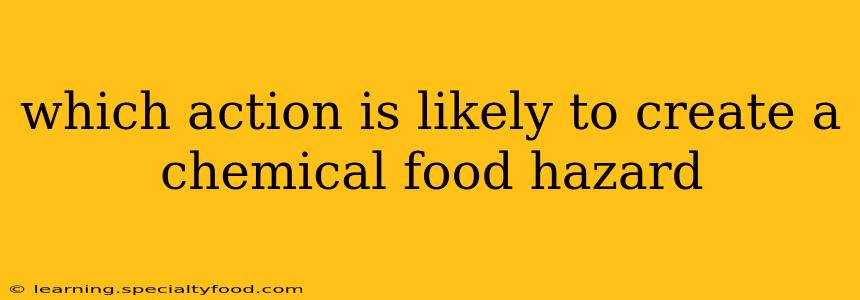Which Action Is Likely to Create a Chemical Food Hazard?
Food safety is paramount, and understanding potential hazards is crucial for preventing illness. A chemical food hazard arises when chemicals contaminate food, making it unsafe to consume. Many actions can lead to such contamination; let's explore some key culprits.
Understanding Chemical Food Hazards:
Chemical hazards aren't limited to obvious toxins. They encompass a wide range of substances that can inadvertently or intentionally find their way into our food, including:
- Pesticides: Residues left on produce after inadequate washing.
- Cleaning chemicals: Traces of sanitizers or detergents left on surfaces that come into contact with food.
- Metals: Contamination from leaching of metals from cookware, especially with acidic foods.
- Packaging materials: Migration of chemicals from packaging into the food itself.
- Toxins produced by molds or bacteria: These aren't always directly added, but rather a result of improper food storage and handling.
Specific Actions that Create Chemical Food Hazards:
Let's delve into several actions that significantly increase the risk of chemical food contamination:
1. Improper Cleaning and Sanitizing:
- The Hazard: Failing to properly clean and sanitize food preparation surfaces, utensils, and equipment leaves behind residues of cleaning chemicals, potentially contaminating the food.
- Example: Using a dishwasher that isn't properly rinsed, leaving detergent residue on plates that will then come into contact with food.
- Prevention: Thoroughly rinse all dishes, utensils, and surfaces after cleaning with appropriate detergents and follow the manufacturer's instructions for using sanitizers.
2. Using Damaged or Contaminated Packaging:
- The Hazard: Food packaged in damaged containers can be exposed to contaminants, or the packaging itself might leach chemicals into the food.
- Example: Storing food in dented cans that could contain rust or using plastic wrap that's cracked or broken.
- Prevention: Inspect all packaging before use, discarding any damaged containers. Be mindful of the materials used in packaging and opt for food-safe containers whenever possible.
3. Incorrect Food Storage:
- The Hazard: Improper storage can lead to the leaching of chemicals from containers or the growth of mold, which produces mycotoxins (harmful chemical compounds).
- Example: Storing acidic foods in non-food-grade plastic containers, or leaving food out at room temperature for extended periods, allowing mold growth.
- Prevention: Use food-grade containers appropriate for the type of food being stored. Refrigerate or freeze perishable foods promptly to prevent microbial growth.
4. Using Improper Cookware:
- The Hazard: Certain cookware can leach metals into food, especially acidic foods. Non-stick coatings can also degrade and release harmful chemicals at high temperatures.
- Example: Using scratched or damaged non-stick cookware, cooking acidic foods (like tomato sauce) in aluminum pots for extended periods.
- Prevention: Use food-safe cookware appropriate for high heat. Avoid using scratched or damaged non-stick pans. Consider using stainless steel or cast iron for more robust options.
5. Pesticide Residue on Produce:
- The Hazard: Pesticides, even at low levels, can pose a health risk if not properly removed.
- Example: Failing to wash fruits and vegetables thoroughly before consumption.
- Prevention: Thoroughly wash all produce under running water before consumption. Consider using a vegetable brush to scrub away dirt and residue.
6. Cross-Contamination with Cleaning Supplies:
- The Hazard: Storing cleaning supplies near food or using the same cutting boards for food and cleaning can lead to contamination.
- Example: Preparing food on a cutting board that was previously used to clean raw meat with a harsh chemical sanitizer without proper cleaning in between.
- Prevention: Store cleaning supplies separately from food and dedicate specific cutting boards for raw meat and other food items. Always thoroughly clean and sanitize cutting boards between uses.
By understanding these potential hazards and following safe food handling practices, we can significantly reduce the risk of chemical food hazards and ensure the safety and quality of our food. Remember, prevention is always the best cure when it comes to food safety.
